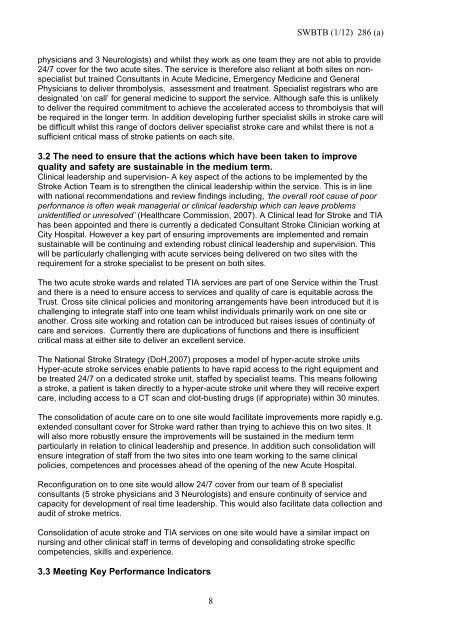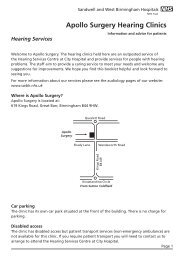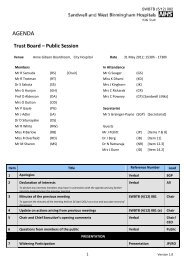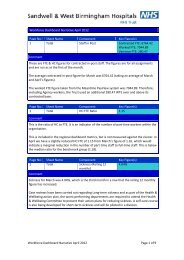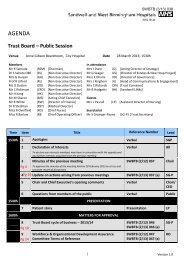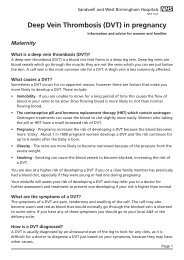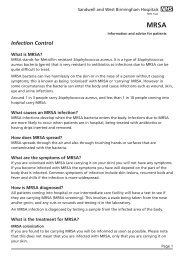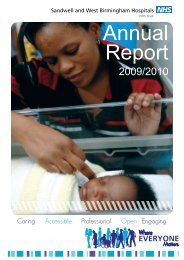January 2012 - Sandwell & West Birmingham Hospitals
January 2012 - Sandwell & West Birmingham Hospitals
January 2012 - Sandwell & West Birmingham Hospitals
You also want an ePaper? Increase the reach of your titles
YUMPU automatically turns print PDFs into web optimized ePapers that Google loves.
SWBTB (1/12) 286 (a)<br />
physicians and 3 Neurologists) and whilst they work as one team they are not able to provide<br />
24/7 cover for the two acute sites. The service is therefore also reliant at both sites on nonspecialist<br />
but trained Consultants in Acute Medicine, Emergency Medicine and General<br />
Physicians to deliver thrombolysis, assessment and treatment. Specialist registrars who are<br />
designated ‘on call’ for general medicine to support the service. Although safe this is unlikely<br />
to deliver the required commitment to achieve the accelerated access to thrombolysis that will<br />
be required in the longer term. In addition developing further specialist skills in stroke care will<br />
be difficult whilst this range of doctors deliver specialist stroke care and whilst there is not a<br />
sufficient critical mass of stroke patients on each site.<br />
3.2 The need to ensure that the actions which have been taken to improve<br />
quality and safety are sustainable in the medium term.<br />
Clinical leadership and supervision- A key aspect of the actions to be implemented by the<br />
Stroke Action Team is to strengthen the clinical leadership within the service. This is in line<br />
with national recommendations and review findings including, ‘the overall root cause of poor<br />
performance is often weak managerial or clinical leadership which can leave problems<br />
unidentified or unresolved’ (Healthcare Commission, 2007). A Clinical lead for Stroke and TIA<br />
has been appointed and there is currently a dedicated Consultant Stroke Clinician working at<br />
City Hospital. However a key part of ensuring improvements are implemented and remain<br />
sustainable will be continuing and extending robust clinical leadership and supervision. This<br />
will be particularly challenging with acute services being delivered on two sites with the<br />
requirement for a stroke specialist to be present on both sites.<br />
The two acute stroke wards and related TIA services are part of one Service within the Trust<br />
and there is a need to ensure access to services and quality of care is equitable across the<br />
Trust. Cross site clinical policies and monitoring arrangements have been introduced but it is<br />
challenging to integrate staff into one team whilst individuals primarily work on one site or<br />
another. Cross site working and rotation can be introduced but raises issues of continuity of<br />
care and services. Currently there are duplications of functions and there is insufficient<br />
critical mass at either site to deliver an excellent service.<br />
The National Stroke Strategy (DoH,2007) proposes a model of hyper-acute stroke units<br />
Hyper-acute stroke services enable patients to have rapid access to the right equipment and<br />
be treated 24/7 on a dedicated stroke unit, staffed by specialist teams. This means following<br />
a stroke, a patient is taken directly to a hyper-acute stroke unit where they will receive expert<br />
care, including access to a CT scan and clot-busting drugs (if appropriate) within 30 minutes.<br />
The consolidation of acute care on to one site would facilitate improvements more rapidly e.g.<br />
extended consultant cover for Stroke ward rather than trying to achieve this on two sites. It<br />
will also more robustly ensure the improvements will be sustained in the medium term<br />
particularly in relation to clinical leadership and presence. In addition such consolidation will<br />
ensure integration of staff from the two sites into one team working to the same clinical<br />
policies, competences and processes ahead of the opening of the new Acute Hospital.<br />
Reconfiguration on to one site would allow 24/7 cover from our team of 8 specialist<br />
consultants (5 stroke physicians and 3 Neurologists) and ensure continuity of service and<br />
capacity for development of real time leadership. This would also facilitate data collection and<br />
audit of stroke metrics.<br />
Consolidation of acute stroke and TIA services on one site would have a similar impact on<br />
nursing and other clinical staff in terms of developing and consolidating stroke specific<br />
competencies, skills and experience.<br />
3.3 Meeting Key Performance Indicators<br />
8


